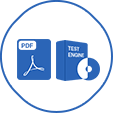Last Update 7 hours ago Total Questions : 160
The Entry Certificate in Business Analysis (ECBA) content is now fully updated, with all current exam questions added 7 hours ago. Deciding to include ECBA practice exam questions in your study plan goes far beyond basic test preparation.
You'll find that our ECBA exam questions frequently feature detailed scenarios and practical problem-solving exercises that directly mirror industry challenges. Engaging with these ECBA sample sets allows you to effectively manage your time and pace yourself, giving you the ability to finish any Entry Certificate in Business Analysis (ECBA) practice test comfortably within the allotted time.
What tool can be used to determine the impact of a changed requirement on other requirements?
During the requirement life cycle management, what should a business analyst (BA) do to extend the value of requirements beyond the current initiative?
If a business analyst (BA) does not properly identify stakeholders, then the long-term implications are:
Which type of elicitation involves obtaining information by controlled test?
Which techniques are used for performing reviews?
How does the use of a traceability repository help in achieving project goals?
What is a risk that business analysts (BAs) look for when managing stakeholder engagement?

